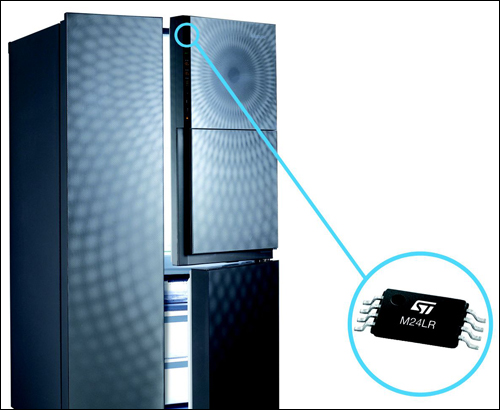Korean electronics and home appliance firm Dongbu Daewoo Electronics is selling a Near Field Communication (NFC)-enabled refrigerator in Korea that allows users to track the condition and efficiency of their kitchen appliance, by means of an NFC smartphone loaded with a Dongbu Daewoo application. The fridge comes with sensors and a processor that track the conditions within, wired to an STMicroelectronics (SMT) M24LR NFC RFID tag that transmits that data when interrogated by an NFC reader. The system, known as Klasse Smart, is just the beginning for the incorporation of NFC technology into home appliances, predicts Sylvain Fidelis, STMicroelectronics’ marketing manager.
With the continued proliferation of NFC technology, Fidelis explains, the appliance manufacturer determined that the market was ready for a smarter refrigerator that could “talk” to consumers about their appliance’s condition, as well as link them to necessary service representatives. The refrigerator comes with sensors to detect whether any of its three compartments are open, and to measure the temperature within each compartment. It also includes a processor that tracks the appliance’s energy consumption. All of that data is then stored on an STMicroelectronics M24LR NFC tag containing 8 kilobytes of memory. The tag stores the information until queried by a user equipped with an NFC phone, at which time it transmits that data, and the user’s app then displays any relevant information.

A user with an NFC reader built into a phone or tablet would first read the appliance’s tag, and then download Dongbu Daewoo’s Klasse Smart app. At that time, that person would be invited to select which functions he or she wishes to activate—for example, the user could track specific details, such as the temperature within one of the machine’s three compartments, or the length of time that a door was left open, and how frequently this occurred. Those options are then saved, with the user’s profile linked to his or her mobile phone or tablet reader.
A user wishing to learn about the refrigerator’s performance or activity can tap the reader against the tag, installed toward the top front of the machine, on the door’s exterior. The tag is wired to the fridge’s sensors and processor. Once interrogated, the tag transmits the data via a high-frequency (HF) 13.56 MHz signal, using the ISO 15693 air-interface protocol.
The phone then forwards that data to Dongbu Daewoo’s server, which stores the information about the refrigerator’s functionality and sensor details, along with any other data that should be displayed for that particular user.
If the refrigerator processor determines that it is not operating as efficiently as it should be, based on the accumulated sensor data, the appliance flashes a light-emitting diode (LED) to warn the consumer. The individual can then tap his or her phone against the tag, retrieve all of the data and select the app’s diagnosis menu, in order to learn what issue had triggered the warning, as well as instructions for resolving the problem.
“We see this as a great opportunity for our dynamic NFC tags,” Fidelis states. Due to the proliferation of NFC readers in mobile phones and tablets, he notes, consumers now have the readers necessary to begin taking advantage of this technology on a wider scale. Other appliance manufacturers are presently considering solutions that utilize NFC as well, and many of the initial use cases are in Korea.
NFC’s adoption in Korea has outpaced that of the rest of the world, according to John Devlin, the practice director of security and ID at market-research firm ABI Research. Much of the technology’s proliferation in that country, he explains, resulted from the adoption of T-money, a system using rechargeable NFC-enabled cards and handsets to enable consumers to pay for fares on buses, subways and other modes of public transportation, as well as make payments at convenience stores and other businesses in lieu of using cash or credit cards. Devlin says there are currently 20 million handsets with NFC readers in use in that country.
Appliance manufacturers worldwide are now piloting the technology, STMicroelectronics reports, including an oven manufacturer that is testing use of the company’s NFC tags, by retrieving data from an NFC tag and then setting the appliance’s settings accordingly. For example, a user could access the oven manufacturer’s Web site using an app on a smartphone, and then access a recipe for a specific food item. After preparing the dish, that individual would tap his or her phone against a tag wired to the oven’s microprocessor, which would receive data from the phone indicating the status of the dish he was making. The tag would then forward instructions to the oven’s processor to set the temperature and cooking time according to that recipe’s specifications.
Other use cases for STMicroelectronics’ technology include NFC-enabled power switches or motion and pressure sensors, either to prompt the appliance to respond to a user’s changed settings via NFC technology, or to send sensor data to the user based on the information it retrieves from the appliance’s sensors or processors.

